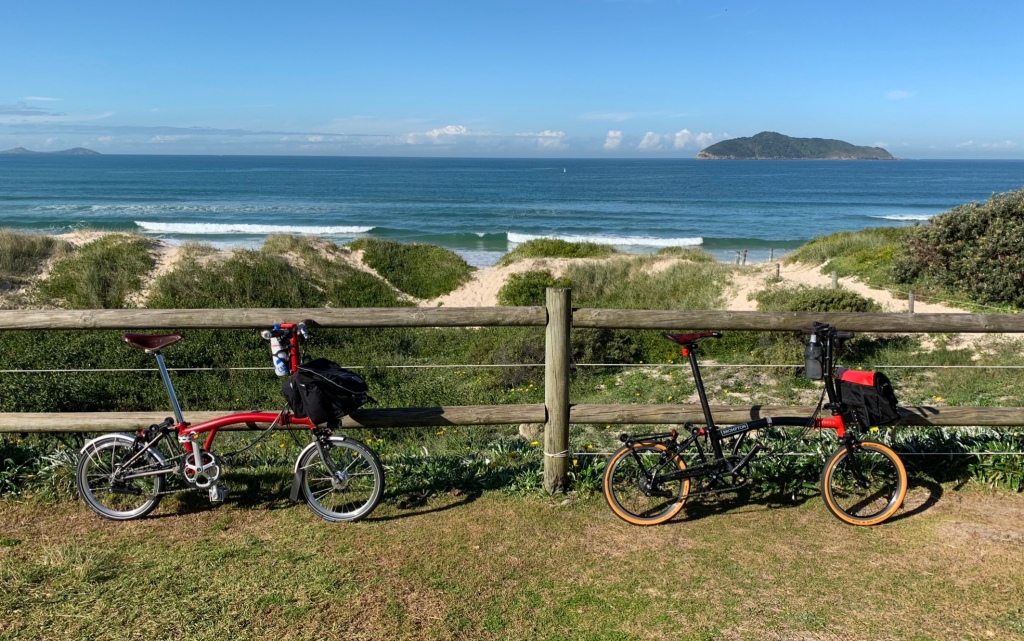Pre-Brompton came Mungo, a Dahon Vector 27-speed 20″ wheel size folding bike. With thoughts of traveling & not wanting to go through the difficulties of transporting a full-sized bike via airlines & rental vehicles, Mungo gave me a near-road bike feel & with a good range of gears. However, Mungo also showed that it was still going to be a case of disassembly if I hoped to travel with an airlines-compatible single case or soft bag & avoid needing a larger-sized rental car. Fortunately, 2 Bromptons unexpectedly/miraculously came along via eBay “Buy now” purchases & Mungo lost out on seeing the world? (As has Daisy, a Dahon Vitesse 18-speed flat-bar model that Mrs Aussie also found via eBay.)
Another purchase for local travels & trips has been the Tardis, our VW T5 Campervan. While our T5 has a good spot for one Brompton in the rear compartment under the bed, a rear bike carrier is necessary for whichever of our bikes go with us on multi-day trips. Mungo & Daisy fit well with the Tardis trips; all-purpose bikes with mudguards, side-stands & nice rides but with the added benefit of foldability for storage when we don’t want to lock them (unfolded) on the bike rack.
Warning: some paragraphs follow that involve mathematics. Perhaps you may have a need to scroll/swipe to the last paragraph & pic?
What an all-purpose bike also needs, is a range of gears that will suit most terrains that our trips take us to. Rather than just test riding a bike up every hill you can find, to see if the gear ratios are suitable, a means of comparing gear ratios is to obtain/calculate the “Gear Inches” (GI) by multiplying the gear ratios for bottom & top gears by the diameter of the wheel. For some people this may be somewhat difficult but for me I’ve already dug out the hub gear info (eg via Hub Gear Calculators on the Internet), I can count the teeth on the rear cogs & chainrings, & I can measure the wheel diameter. Actually, this last item is usually very difficult if you’re resorting to a tape measure so the best way is to calculate the diameter from the ETRTO size on the tyre. The ETRTO size for a Brompton Kojak is 32-349 & the formula for calculating wheel diameter in inches is (2×32+349)/25.4 (ie 413/25.4 = 16.25). An additional tip if you want to set your bike computer wheel size, is that the wheel diameter of 413mm can be multiplied by Pi to give the wheel rollout distance of 1297mm. How’s that? & all without needing a tape measure!
Getting back to the GI calculation & using Ralph, my Alfine 11-speed Brompton, as an example, the low speed GI is 50/18×0.53×16.25 which equals 24 (ie chainring teeth divided by rear cog teeth times hub low ratio times wheel diameter). The top speed GI is 50/18×2.15×16.25 = 97 & therefore the GI range can be expressed as 24-97. Once we get the GI for other bikes you can start to compare how the bikes would cope with hills (or even how they might compare for top gear speed?)
Before I eventually resume my tale about Mungo, let’s compare some GIs. A typical road/race bike that uses 53 & 39 teeth chain rings & an 11-25 teeth cassette has a GI of 41-126. A mountain bike could be about 17-105, while Robinson, my 6-speed “reduced gearing” Brompton is 29-88 & a 3-speed Brompton would be about 44-79, depending on options. As you may see, nothing beats an MTB on being able to climb hills – just as long as you can keep the front wheel on the ground? Also, if you want to go fast on your Brompton on the flat then you’ll have to pedal like crazy to be ahead of the race bike.
The beauty of Mungo is the feel of riding a road/race bike with similar gear shifters & fairly light weight, as well as a GI of 28-123. This comes from the small wheel size, a 53 teeth chain ring, an 11-26 teeth cassette & 9-speed rear derailleur but also with a 3-speed SRAM dual-drive rear hub (similar to the 6-speed Brompton with a 2-speed derailleur setup & a 3-speed hub?). A scan of the above GI figures should show that Mungo is ably suited to getting up hills, as well as being pedaled fast.
Unfortunately for me, my heart-related limited blood/oxygen capacity (refer earlier blog post Hill performance for info) still puts Mungo (& me) at a disadvantage when I compare it to Ralph’s low speed gear climbing ratio. Having resolved Mungo’s original tendency to drop the chain when in top gear (by fitting a fixed front derailleur to contain the chain onto the front chainring) & considering that Mungo’s missed out on any overseas trips, it seemed a shame that Ralph could be preferred for climbing hills reached while on Tardis trips? No, Mungo wasn’t going to lie down & its standard crankset size suggested to me that a 39 teeth chainring from my box of bike bits was going to be a good swap with the usual 53 teeth item? So, here’s a pic of Mungo now equipped with the smaller front chainring (which provides a GI of 21-90, seems to escape the MTB tendency to wave the front wheel on steep hills & still gives a top gear “adequate” for my current capabilities?). Mungo rides again?!









